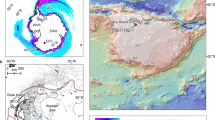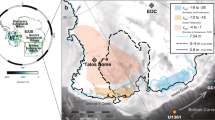Abstract
Ice-sheet behaviour is disproportionately controlled by the dynamics of outlet glaciers that terminate in the ocean1,2. However, outlet-glacier dynamics—particularly over timescales longer than the observational record—are not well understood3, leading to uncertainties in our models of ice-sheet response to climate change. Here we use 10Be exposure ages and radiocarbon dating from the Sam Ford Fjord in the Canadian Arctic to reconstruct the retreat chronology of an outlet glacier of the Laurentide ice sheet, following the last glacial termination. We find that Sam Ford Fjord, which has a similar morphology to the troughs holding many outlet glaciers of the Greenland ice sheet, was rapidly deglaciated about 9,500 years ago, with retreat rates ranging from 5 to 58 m yr−1. The highest rates occurred in the deepest part of the fjord (900 m), whereas regions beyond the fjord mouth and up-valley of the head of the fjord experienced the lowest rates of retreat. We conclude that in such a fjord setting, there is a strong bathymetric control on the retreat of marine outlet glaciers: once the terminus of the outlet glacier retreated into deeper waters, increasing calving rates and basal sliding speeds caused the glacier to rapidly thin and retreat, stabilizing only when it reached the shallow inland head of the fjord.
This is a preview of subscription content, access via your institution
Access options
Subscribe to this journal
Receive 12 print issues and online access
$259.00 per year
only $21.58 per issue
Buy this article
- Purchase on Springer Link
- Instant access to full article PDF
Prices may be subject to local taxes which are calculated during checkout


Similar content being viewed by others
References
Bennet, M. R. Ice streams as the arteries of an ice sheet: Their mechanisms, stability and significance. Earth Sci. Rev. 61, 309–339 (2005).
Rignot, E. & Kanagaratnam, P. Changes in the velocity structure of the Greenland ice sheet. Science 311, 986–990 (2006).
IPCC. Climate Change 2007: The Physical Science Basis. Contribution of Working Group I to the Fourth Assessment Report of the Intergovernmental Panel on Climate Change (eds Solomon, S., Qin, D., Manning, M., Chen, Z., Marquis, M., Averyt, K. B., Tignor M., and Miller, H. L.) (Cambridge Univ. Press, 2007).
Kessler, M. A., Anderson, R. S. & Briner, J. P. Fjord insertion into continental margins driven by topographic steering of ice. Nature Geosci. 1, 365–369 (2008).
Joughin, I., Abdalati, W. & Fahnestock, M. Large fluctuations in speed on Greenland’s Jakobshavn Isbrae glacier. Nature 432, 608–610 (2004).
Howat, I. M., Joughin, I. & Scambos, T. A. Rapid changes in ice discharge from Greenland outlet glaciers. Science 315, 1559–1561 (2007).
Nick, F. M., Vieli, A., Howat, I. M. & Joughin, I. Large-scale changes in Greenland outlet glacier dynamics triggered at the terminus. Nature Geosci. 2, 110–114 (2009).
Parizek, B. R. & Alley, R. B. Ice thickness and isostatic imbalances in the Ross Embayment, West Antarctica: Model results. Glob. Planet. Change 42, 265–278 (2004).
Pfeffer, W. T. A simple mechanism for irreversible tidewater glacier retreat. J. Geophys. Res. 112, F03S25 (2007).
Van de Wal, R. S. W. et al. Large rapid melt-induced velocity changes in the ablation zone of the Greenland Ice Sheet. Science 321, 111–113 (2008).
Clark, P. U., Alley, R. B. & Pollard, D. Northern Hemisphere ice-sheet influences on global climate change. Science 286, 1104–1111 (1999).
Stone, J. O. et al. Holocene deglaciation of Marie Byrd Land, West Antarctica. Science 299, 99–102 (2003).
Johnson, J. S., Bentley, M. J. & Gohl, K. First exposure ages from the Amundsen Sea Embayment, West Antarctica: The late Quaternary context for recent thinning of Pine Island, Smith, and Pope Glaciers. Geology 36, 223–226 (2008).
Dyke, A. S., Moore, A. & Robinson, L. Deglaciation of North America. Geol. Surv. Can. Open File 1574 (2003).
Bentley, M. J. et al. Early Holocene retreat of the George VI Ice Shelf, Antarctic Peninsula. Geology 33, 173–176 (2005).
Andrews, J. T. & Ives, J. D. ‘Cockburn’ nomenclature and the Late Quaternary history of the eastern Canadian Arctic. Arctic Alpine Res. 10, 617–633 (1978).
Buckley, J. T. Gradients of past and present outlet glaciers. Geol. Surv. Pap. Can. 69-29 (1969).
Kaplan, M. R. & Miller, G. H. Early Holocene delevelling and deglaciation of the Cumberland Sound region, Baffin Island, Arctic Canada. Geol. Soc. Am. Bull. 115, 445–462 (2003).
Briner, J. P., Miller, G. H., Davis, P. T. & Finkel, R. C. Cosmogenic radionuclides from fiord landscapes support differential erosion by overriding ice sheets. Geol. Soc. Am. Bull. 118, 406–420 (2006).
Davis, P. T., Briner, J. P., Coulthard, R. D., Finkel, R. C. & Miller, G. H. Preservation of arctic landscapes overridden by cold-based ice sheets. Quat. Res. 65, 156–163 (2006).
Briner, J. P., Miller, G. H., Finkel, R. & Hess, D. P. Glacial erosion at the fiord onset zone and implications for the organization of ice flow on Baffin Island, Arctic Canada. Geomorphology 97, 126–134 (2008).
Andrews, J. T. & Barnett, D. M. Holocene (Neoglacial) moraine and proglacial lake chronology, Barnes Ice Cap, Canada. Boreas 8, 341–358 (1979).
Benn, D. I., Warren, C. R. & Mottram, R. H. Calving processes and the dynamics of calving glaciers. Earth Sci. Rev. 82, 143–179 (2007).
Axford, Y., Briner, J. P., Miller, G. H. & Francis, D. R. Paleoecological evidence for abrupt cold reversals during peak Holocene warmth on Baffin Island, Arctic Canada. Quat. Res. 71, 142–149 (2009).
Dyke, A. S., Dale, J. E. & McNeely, R. N. Marine molluscs as indicators of environmental change in glaciated North America and Greenland during the last 18,000 years. Geog. Phys. Quat. 50, 125–184 (1996).
Holland, D. M., Thomas, R. H., De Young, B., Ribergaard, M. H. & Lyberth, B. Acceleration of Jakobshavn Isbrae triggered by warm subsurface ocean waters. Nature Geosci. 1, 659–664 (2008).
Scambos, T. A., Bohlander, J. A., Shuman, C. A. & Skvarca, P. Glacier acceleration and thinning after ice shelf collapse in the Larsen B embayment, Antarctica. Geophys. Res. Lett. 31, L18402 (2004).
Pfeffer, W. T., Harper, J. T. & O’Neel, S. Kinematic constraints on glacier contributions to 21st century sea-level rise. Science 321, 1340–1343 (2008).
Balco, G., Stone, J., Lifton, N. & Dunai, T. A complete and easily accessible means of calculating surface exposure ages or erosion rates from 10Be and 26Al measurements. Quat. Geochron. 3, 174–195 (2008).
Balco, G. et al. Regional beryllium-10 production rate calibration for late-glacial northeastern North America. Quat. Geochron. 4, 93–107 (2009).
Acknowledgements
We express sincere thanks to many people who helped this project along the way: J. Qillaq of Clyde River; R. Finkel and D. Rood at Lawrence Livermore National Laboratory; M. Caffee and others at PRIME Lab; T. Bank, B. Csatho, L. Håkansson, E. Thomas and N. Young in the Department of Geology, University at Buffalo; S. Lehman and C. Wolak at the INSTAAR Laboratory for AMS Radiocarbon Preparation and Research. This project was financially supported by NSF grant EAR-0644966.
Author information
Authors and Affiliations
Contributions
J.P.B. and R.S.A. instigated and directed this research. All authors participated in fieldwork and designed the field sampling strategy. A.C.B. carried out all sample processing and initial data interpretation. All authors contributed to manuscript preparation.
Corresponding author
Supplementary information
Supplementary Information
Supplementary Information (PDF 329 kb)
Rights and permissions
About this article
Cite this article
Briner, J., Bini, A. & Anderson, R. Rapid early Holocene retreat of a Laurentide outlet glacier through an Arctic fjord. Nature Geosci 2, 496–499 (2009). https://doi.org/10.1038/ngeo556
Received:
Accepted:
Published:
Issue Date:
DOI: https://doi.org/10.1038/ngeo556



